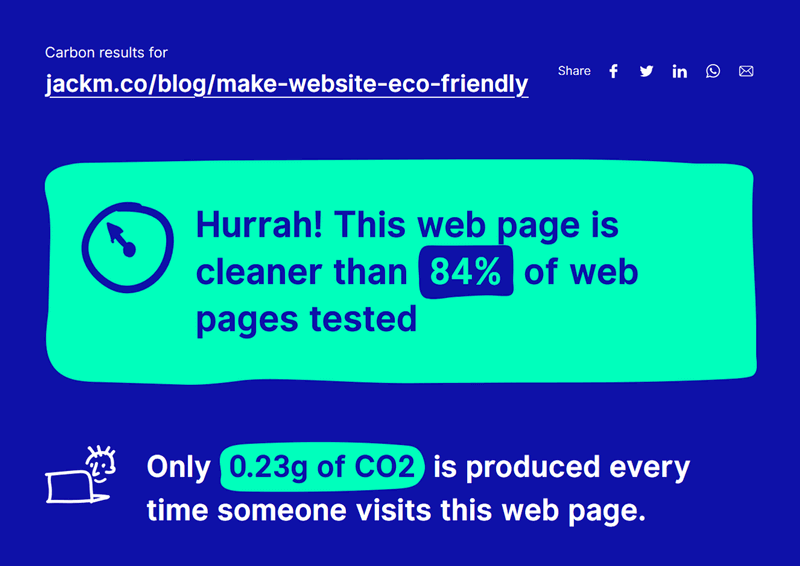Everything seems to have a carbon footprint these days — even your website. The internet accounts for almost as much carbon emission as the aviation industry does — maybe even more in years to come. But you can actively ensure your website is part of the solution, not the problem by reducing your site’s carbon footprint — in addition to ensuring it’s eco-friendly to begin with.
What is a carbon footprint?
A carbon footprint is the amount of greenhouse gas emissions (typically carbon dioxide and methane) released into the air as a result of activity done by a particular person, company, organization, industry etc.
It is possible to calculate your own personal carbon footprint, though this can get complicated. Some of the things to evaluate include your travel, diet, energy use and shopping habits. It turns out a single average human is responsible for 4-20 tonnes of emissions each year.
But what about websites?
An average website produces about 1.76 grams of CO2 per page view. If your website is getting 5,000 views per month, that means it’s emitting about 105 kg of CO2 per year. 15,000 views per month would send out almost 317 kg of CO2 per year, around the same as a flight from London to Istanbul. Just think about all the websites in the world — the amount of CO2 emitted from the internet is dizzying.
If you’re panicking a bit, don’t. The first step is to see how much CO2 your website is actually producing. Then, you can work on making your website more eco-friendly and offsetting your carbon emissions.
Start by typing your website’s URL into the Website Carbon Calculator from Wholegrain Digital. The calculator takes things like data transfers, the energy intensity of web data, website traffic and if your data centre powers your website with a green energy source into consideration when calculating your site’s emissions.
The results are clearly stated, explaining your website’s CO2 emissions. Your site will be compared to others, letting you know if yours is cleaner (or not) than most other websites.
Here are the results from of one of my recent blog posts:

Viewing these simple comparisons will give you a clearer view of where your website stands. For example, the last website I checked explained that it had used 212kWh of energy, enough electricity to drive an electric car 1,357km over the course of a year with 10,000 views per month.
The carbon calculator also explains how you can best take action — but more on that later.
The carbon footprint of the world’s most used websites
You might be surprised to find out the carbon footprint of some of the world’s most popular websites — it may not be what you think.
To spice things up a bit, let’s play a game. I tested the carbon footprints of these four websites:




Which websites do you think have the biggest and smallest carbon footprints? No cheating! Take a guess at each of the stats below and then click the coloured boxes to reveal the answers.
1. ________________.com produces 3.20g of CO2 every time someone visits this website. This website is powered by standard energy.

2. ________________.com produces 1.39g of CO2 every time someone visits this website. This website is powered by standard energy.

3. ________________.com produces 1.31g of CO2 every time someone visits this website. This website is powered by sustainable energy.

4. ________________.com produces 0.26g of CO2 every time someone visits this website. This website is powered by sustainable energy.

Don’t worry if you didn’t get them right — the most important thing to know is how clean your own website is. Then you can figure out how to use carbon offsetting in your (and the planet’s) favour.
How to reduce your website’s carbon footprint
It’s easy to help reduce your website’s carbon footprint. There are many ways you can do this:
- Optimise your website. Websites that are slow and lagging often need to be optimised to work faster and more sustainably. I can help you optimise your site and make sure it’s running as sustainably as possible.
- Switch to an eco-friendly web host. As you’ve noticed by the above quiz, some major websites use sustainable web hosting and some don’t. Why not make the switch to a more sustainable host such as Eco Web Hosting or Green Geeks*? I can also help you make your site’s transition to an eco-friendly web host smooth and simple.
- Consider offsetting your carbon use. Some of the best ways to do this will be detailed out below.
What is carbon offsetting?
Carbon offsetting goes beyond just making your website sustainable. It’s kind of like a trade: you do something to make up for the emissions your website has put out. You can invest in an eco-positive project that in turn reduces greenhouse gas emissions. Essentially, it evens out the playing field.
There are many benefits of carbon offsetting your website:
- Your website’s carbon footprint is balanced
- You’re setting a solid example for other websites
- If others follow your lead, real change can happen
- You’ll attract readers/clients/customers that find sustainability important
How to offset your website’s carbon use
Even with eco-friendly web hosting and sustainable website optimisation, your website will still leave a carbon footprint. The good news is you can reduce this carbon footprint by offsetting it in a variety of ways.
The most popular way to do this is by planting trees using a website like Tree Nation or One Tree Planted. You could also consider supporting carbon offset projects that help bring renewable energy options or clean water to developing countries or groups of people that need it. Some of these are things like Panama Wind Energy, ceramic water cooler production in Cambodia or efficient household cookstoves in Kenya.
Gold Standard Certified Emission Reductions price their offset options by tonne. These projects range from things like funding solar energy in India or chlorine water dispensers in Uganda.
Bottom line
The internet leaves a major carbon footprint that contributes to climate change. Make sure to handle your website’s carbon footprint with eco-friendly web optimisation and with carbon offsets like planting trees or supporting renewable energy projects. Don’t be Amazon.com, instead, plant trees in the Amazon.
I’m happy to help you optimise your website and to make it more sustainable. For more information or a quote, feel free to contact me here.
* An affiliate link to a company I personally use and recommend. I’ll receive a small commission if you sign up with them but it won’t effect the price you pay.


